Cruising with Fathom Travel & Volunteering in the Dominican Republic

It’s taking me a bit to share my experiences while cruising to and volunteering in the Dominican Republic with Fathom Travel because it was such an overwhelming experience on so many levels. First, it was the very first time my youngest boys had visited the country. Yes, I lived there for many years (from 9 to 18) and yes, my father and other family still live there, and though I have been back a few times, taking my kids is just something we have never done. Second, it was a trip that involved getting into the communities, at times even into someone’s home and offer a service, through volunteerism.
Volunteerism through travel, or voluntourism, has been covered by many often highlighting the good and mostly bad in the efforts (and profiting) of companies who organize these types of experiences for travelers looking to do something more meaningful and a bit more impactful with their vacation time. I grew up spending a lot of time in hotels and resorts on the island because of my dad’s work in hospitality and so I learned a lot about tourists and their expectations and behaviors from a very early age. Though I have been critical of the Dominican Republic’s politics, I am also very proud and protective of my heritage and people. So, it was with a strong sense of curiosity and emotions that I embarked on the journey.
I want to share what it was like to expose my kids to the country and culture and my most personal thoughts on this experience, but I have decided to write a separate post on that issue. I will also share my personal conversations with locals on what is happening with Haitians in the country, so please stay tuned for more.
In this post, I want to share my impressions on Fathom Travel’s cruise, the work they are doing, as well as what some locals had to say about it. I want to disclose up front that we were guests of Fathom Travel for the purpose of this review, but as those who invited me already know, my opinions are my own to share on the matter.
The ship
My immediate impression of the Adonia was how much smaller it is compared to other ships. The capacity is 700. I was both relieved and pleased with this realization. Cruising is not my favorite form of travel. My kids absolutely love it, my husband is dying to go on one soon (so expect more cruise stories in the future), but for me it can be a tad overwhelming to be on a ship with so many people at once. Then there are the logistics of cruising itself that often irk me, like the fact that soda is not free (mind you, I am not a big soda drinker, but find that to be such a silly thing to charge people for), or that you have to pay extra for WiFi, a really nice steak dinner, or an espresso. I am a “charge me for it all upfront” kind of gal. I would even prefer to pay for plans or levels that include or exclude more lux items and not worrying about the bill at the end of the trip. Things add up really quickly and it’s always something I worry about on cruises – counting my dollars and cents while in the middle of the ocean. To avoid any mishaps, I made sure to ask that my children not have charge access to their room key cards and restricted WiFi usage to just myself.
We aren’t huge fans of the saltwater pool (standard for cruises), but on sea days we did dip in once or twice. Speaking of extra charges – there is an adults-only pool, but it is a part of the spa and requires an extra fee to use. I didn’t care since I am not a huge cruise ship pool person, but it was a huge point of contention for other travelers on the trip.
Those general cruising details aside, the Adonia is a lovely little ship. We had an ocean view cabin with a picture window. It had two twin beds and a pull out couch the size of a twin mattress. For my two boys and I, it was cozy and perfect. Because of the size of the ship it was easy to find my boys if they were out and about doing something on their own. The absolute favorite place on the ship for them was the library with tons of books on different topics and genres and a load of board games that the boys and I enjoyed.
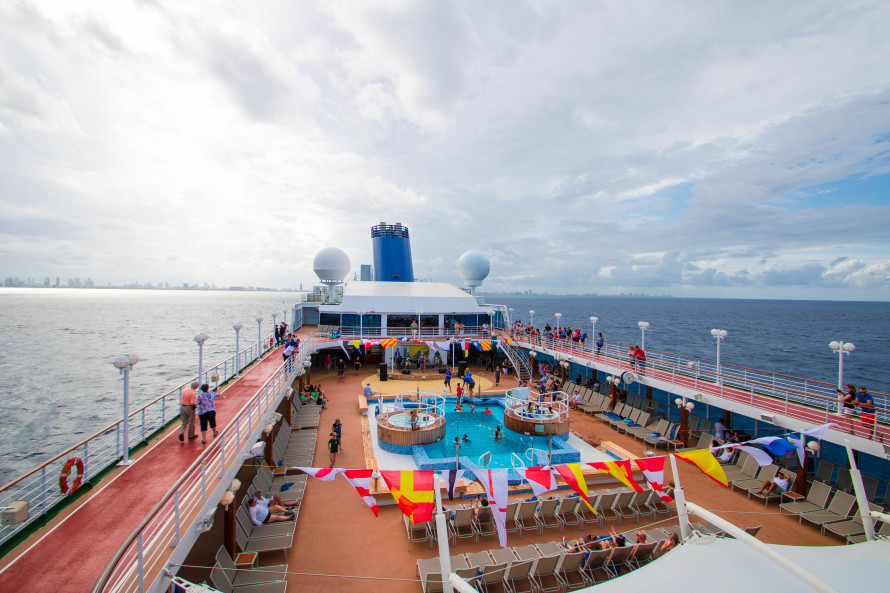
View of Miami skyline from the Adonia.
There are several areas to lounge in and relax as well as a few bars and entertainment spots. The boys loved the main deck for games, music, and get togethers with the new friends they made on the cruise. There are a couple of buffet areas, as well as a main dining room which is beautiful, and a restaurant where you can make reservations and dine in (for an extra charge).
The food
There was always plenty of food and a lot of great options for those wanting to not indulge too much on fatty foods. I was disappointed that there wasn’t food traditional to the destination we were visiting. I was told that the more exclusive restaurant had a Dominican chef, and I saw that the menu offered Dominican dishes, but I didn’t want to incur the extra charge. It’s unfortunate because it didn’t give travelers a taste of the country they were visiting. Had I not ventured out to a local spot once we arrived to the island, I wouldn’t have had any Dominican food during my trip. For the various dishes served, this was something I really wish was offered.
The service, staff, and crew
The staff was great. The wait staff were super friendly and personable. The Fathom Travel team were fun and engaging. My room was always so clean and neat when I arrived to it and I loved the smiles and early morning greetings as we made our way out and back, tired and sleepy each day.
It was clear to me that the Fathom Travel crew enjoy their work and really put their heart, energy, and soul into what they are doing. Many of them come from the Peace Corps or some form of community service and development background. I enjoyed engaging with them, how they engaged with the kids, and having them lead us and encourage us through all of our activities.
Off ship
The overall cruise experience was fun. There was a lot to do, but we never felt bombarded with tons to do. In addition to the volunteering work – or as they call them, the impact activities – there are other excursions offered for an additional fee that allow travelers to enjoy what the area has to offer. (A food tour would be an awesome add!) Most of the impact activities are included in your cruise. Yay! No extra fee!
On our first day, my boys and I went on our own to explore the area. For less than $100 we were able to get a taxi and personal driver for the entire day to drive us all around town and make as many stops as we wanted.
Amber Cove, Carnival Cruise Line’s multimillion dollar port which opened in October of 2015 is a beautiful welcome destination for cruisers. The 25-acre complex has bars, restaurants, a coffee shop, gift shops, as well as a large pool with slides, the use of which is exclusive to cruisers that dock there. Taxis are available just outside the entrance to the complex and many of the drivers speak English.
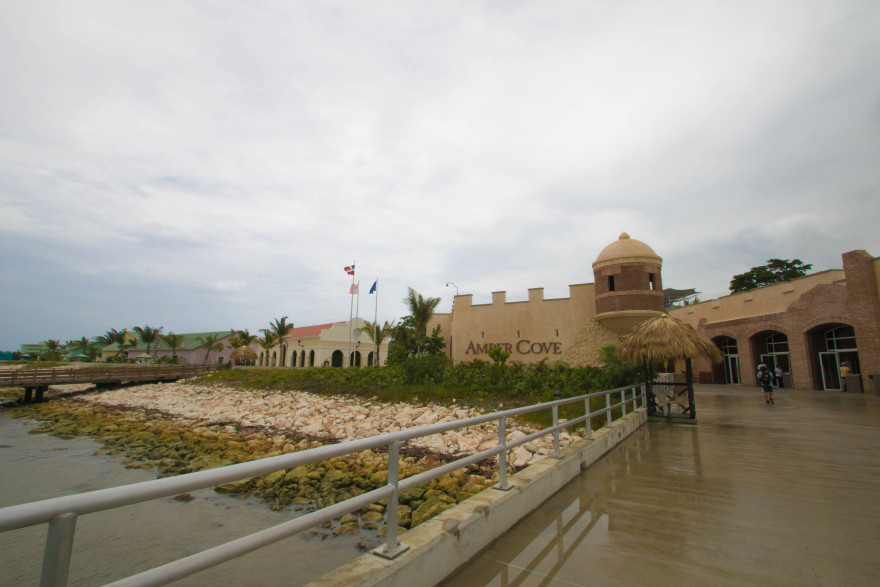
Amber Cove, Puerto Plata
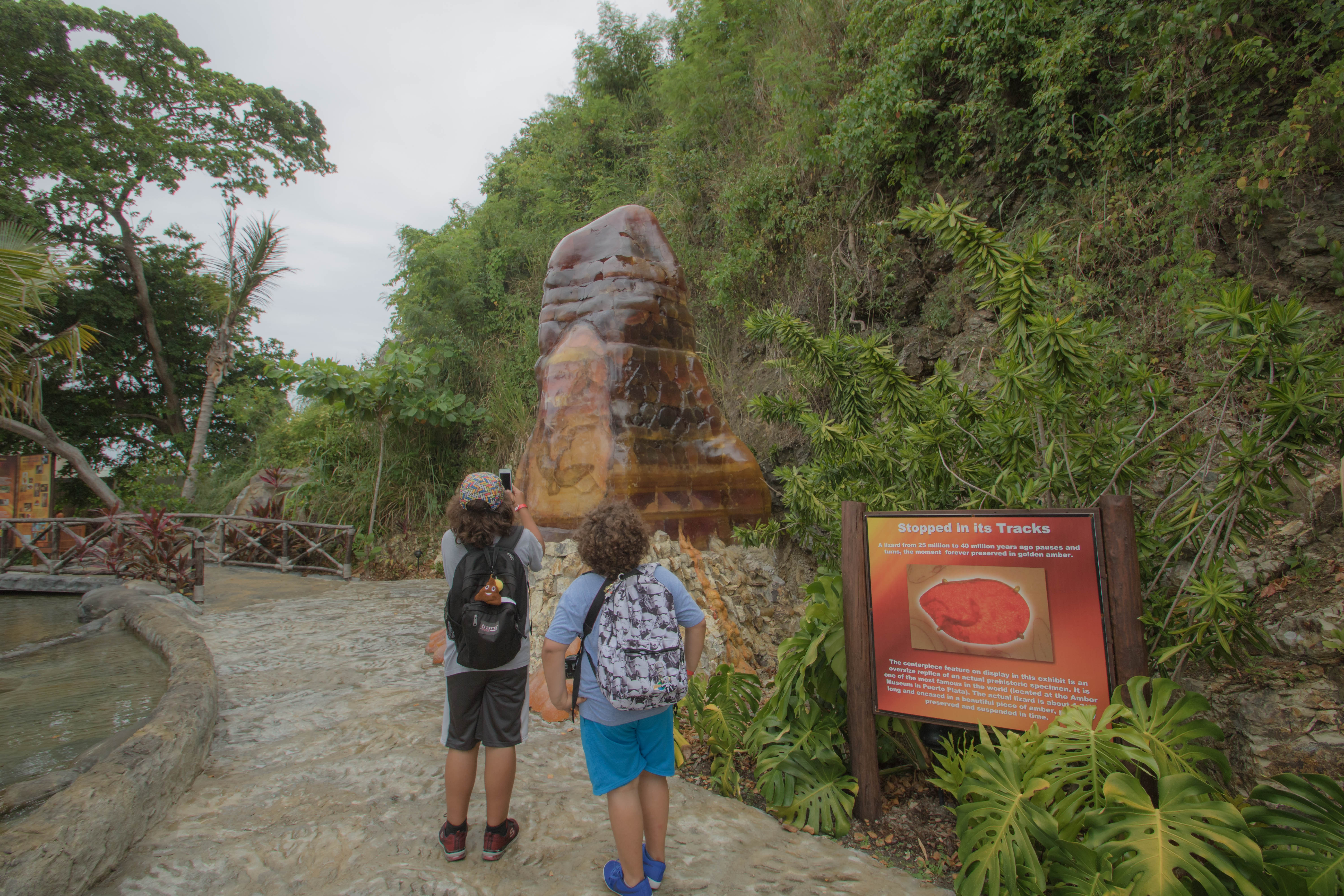
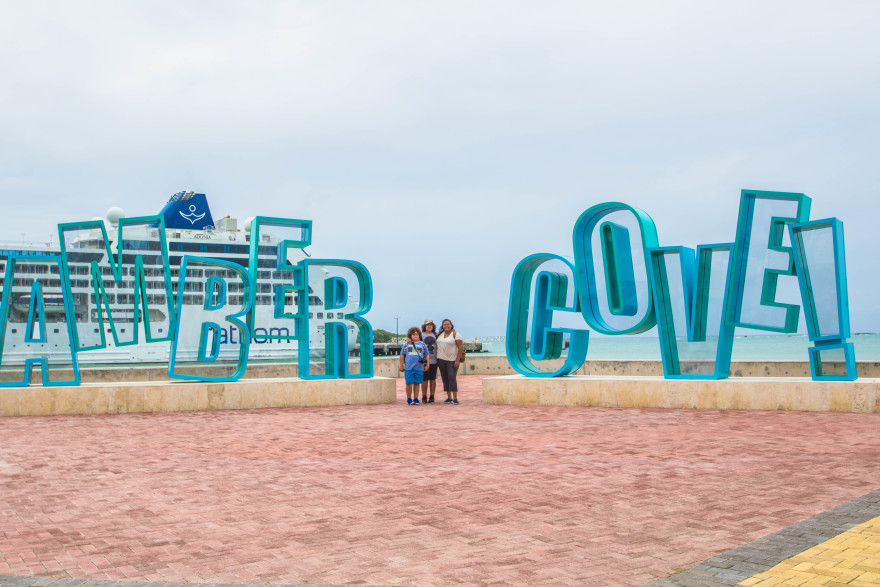

The Impact (Volunteer) Activities
Travelers can choose from a series of impact activities offered through Fathom Travel in partnership with local non-profit organizations and groups. We chose reforestation, cacao making, community English teaching, and making recycled paper. There are two other activities: making water filters and mixing concrete and setting it on homes without floors (kids need to be 13 years or older for this physically demanding activity).
The wonderful aspect of the volunteer opportunities is that this isn’t Fathom, or a foreign organization, coming in to do these things. Fathom is contributing extra labor to already established local organizations in the country. Granted, our participation does help a lot. Many of these local groups have been able to hire-for-pay a lot of their volunteer staff, many of which are students, and it helps in hiring drivers to bus us around. This contributes to the local economy as well as in the other ways the service work helps.
My take on it all
It’s important to note that many of the organizations we came to help, such as Chocal, the chocolate co-op, and RePapel, the recycling center, were already in place before Fathom became involved. These two organizations were the ones that impressed me the most because both were started by groups of women who came together to create something that addressed a need in their communities (such as lack of recycling and high pollution in the case of RePapel) and took advantage of access to goods that fulfilled a demand (such as in the case of Chocal, which takes advantage of the high quantity of cacao plant growth in the region and produces organic, all-natural chocolate). But most importantly, these group of women had a need for a stream of revenue. Most often times many of these single mothers would have to leave their children in the care of others while they traveled to larger cities in search for work. The level of ambition and strong sense of entrepreneurship in these women, much of which grew out of need, has led to help them as well as their communities. I loved that my boys got to see strong Dominican women throughout their journey.
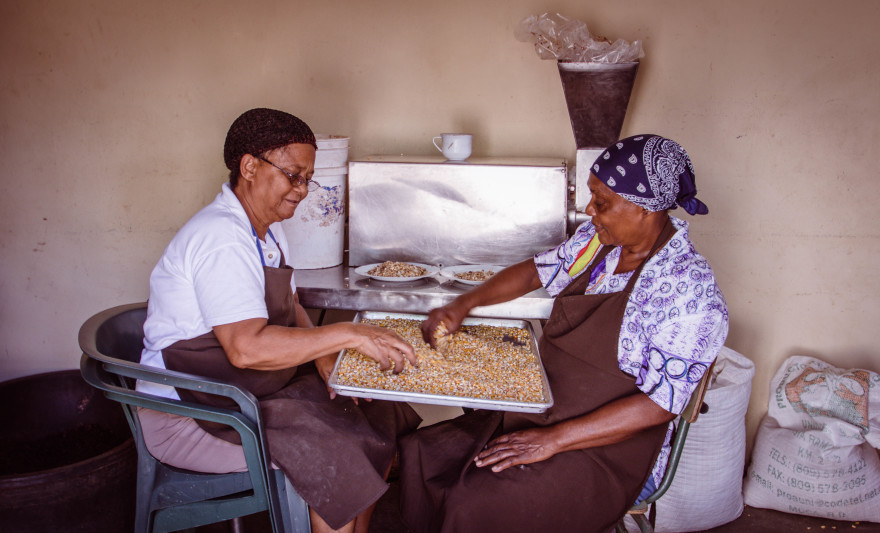
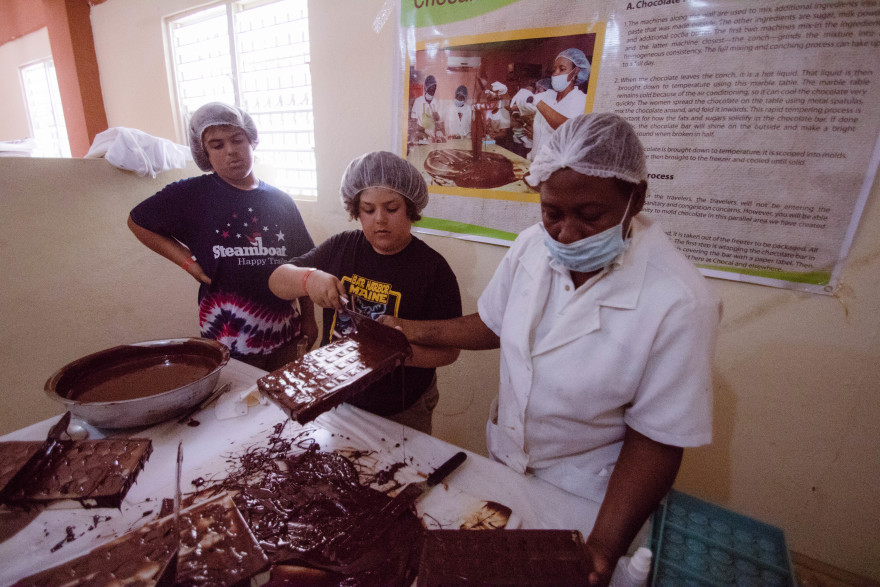

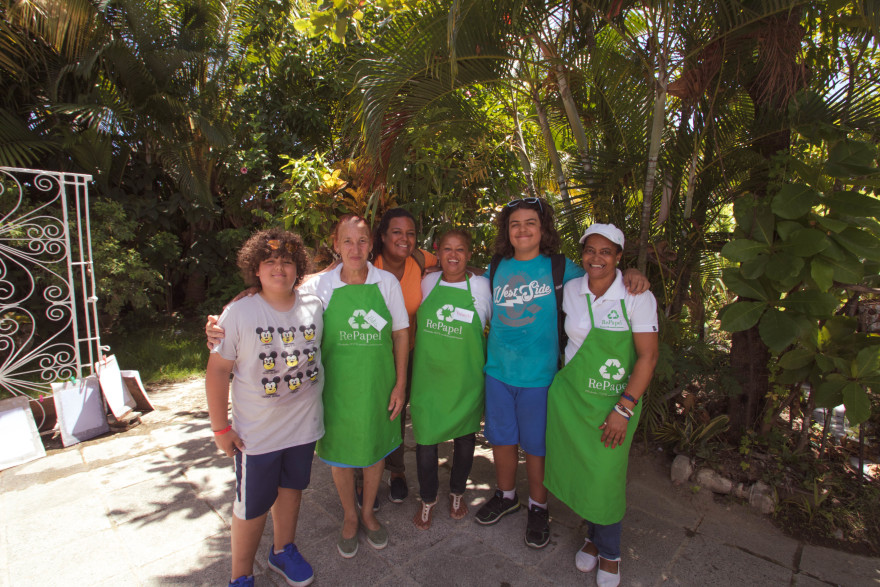
RePapel. Local recycling center.
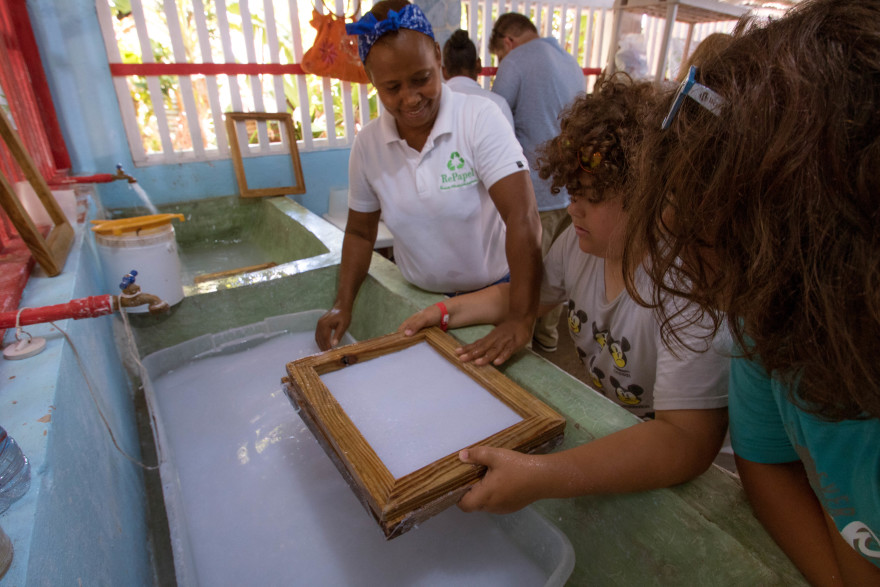
RePapel. Local recycling center.
The partnership with Fathom has enabled them to grow their businesses and employ more workers. Over time, as the businesses become better settled, Fathom will move on to form partnerships with other local groups and companies that are in need of their help.
Often times we talk about walking into these situations with a “savior syndrome”, the idea being that those who come in to do these activities are doing so to help save these communities, and in turn feel good about themselves. There is no question that the work we provide, if only for an hour or two, is significant enough to impact a week’s and even a month’s bottom line. But we aren’t saving anyone. These communities came together and devised a way, often with the help of local experts and professionals, to save themselves. We are the free help, the extra hands, and the added push to get them to their next steps. This is clear from the moment we arrived.
Even when we went into the community to teach English it was clear that we were there to take them to their next learning level. Every single person in our learning group had already been exposed to some form of basic English. Most importantly, they had the eagerness, ambition, and excitement to learn. That isn’t something that I could have ever given them, but it is something that helped me help them learn more. I loved seeing people in our English group take over the class to help someone else in the group. My speaking Spanish was extremely helpful in making the experience fun sooner and setting a tone of confidence quicker, but they were all in, committed to learning.

Community English class.
I was impressed with how the Fathom crew addressed a lot of misconceived notions right before we even arrived to the island. They broke down stereotypes, addressed sensitive topics around poverty and the perception of these communities being a charity case, as opposed to simply being people – just like us – who could really benefit from what we had to offer in time and strength. There was no exchange of money or gifts or trinkets. We gave in sweat and labor and knowledge. And everyone I met was incredibly grateful for it.
I can’t speak for other voluntourism experiences, but I can say that as a Dominican-American, who knows this country, its problems, its people, and its needs, what Fathom Travel is doing, most importantly, how they have chosen to approach it, has left me comfortable enough to say this is one experience I would want every traveler to the island to take on.
What locals had to say
Tourism in the island, though a major source of revenue, is not without its dissent from locals. Amber Cove, the gorgeous port I mentioned earlier, stripped away natural resources and land from locals in the area. The local conservationists we worked with addressed this fact and stated clearly that they viewed our role in the reforestation activity, in part, as a way to give back what was taken for our enjoyment. This honest, bold statement was refreshing to me and fair. Regardless of whether we feel that the tree burning for cattle, or the logging for wooden goods, was our personal problem, we contributed to the tourism demand that enabled the development of a massive port for our enjoyment and impacted forestation in the region. And thus, our role gave back.
The air of judgment, as much as everyone at Fathom tried to address and push aside before we arrived, still influenced how some viewed locals. An example of this was a conversation I overheard from a group who had participated in the reforestation activity. The truth is that when in those rural communities, it is not unusual to see garbage everywhere. Dirty diapers, food containers and cans, plastics bags and more. It leaves an impression and so this group wondered: “Why don’t they take care of their community and surroundings? What are they so dirty and careless?” These thoughts have a way of influencing how we treat and engage and locals can sense it. I sensed it. When the truth is, though pollution is a problem, the other problem is that communities don’t have the support of local government like we do. They don’t always have garbage collectors who come around twice a week to collect their garbage. More often than not, locals have to pack their garbage and drive to the nearest city to drop it off. They not only need a car, but have to also take on the cost of transportation (at the time of this post gas in the region was US$5.00 a gallon). But they watched us coming in to their communities, picking up the garbage, planting trees, and it made an impression on some and that is far more beneficial and useful than trying to label something that we can’t possibly understand. For the record, I have been in NYC when the sanitation department has been on strike and let me tell you, it is not pretty!
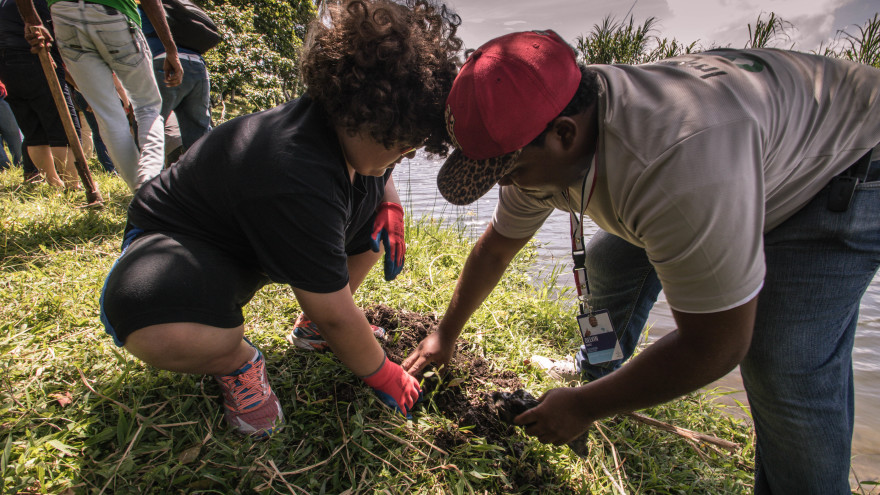
Reforestation.
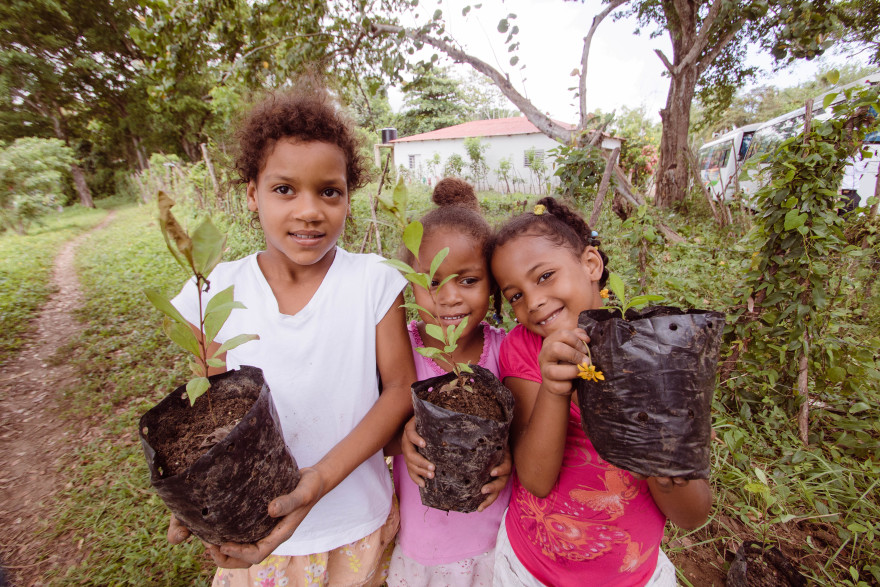
We inspired locals to join in.
Yet, several locals I spoke to – including those in the organizations we worked with – felt grateful. The tourism boom brought on by the new port has helped to improve the economy of the region. The demand for staff and workers has allowed for the drivers, the guides, and the women running the companies we visited, to stay closer to home with their families. The taxi drivers benefit from the tips and high demand from the cruisers looking to get out and about. The fishermen, who serve the many local restaurants in Maimon, the town where the port is located, have been able to prosper despite the port taking up so much territory. It has helped to balance some of the impact.
There is an increased desire to stay in school, to learn English, and improve their knowledge in hospitality because of the influx of tourists.
There is no denying that socio-economic conflicts still exist. Many expats have moved into the area and forced the increase of property values beyond what is affordable to most locals. Gentrification is a threat to the area. However, locals tell me that the other side to it is opportunity to ride the wave. For those involved in the organizations that work with Fathom, they feel the benefits have many levels. Some are continuing in gaining the experiences needed to pursue the path for a career in hospitality, others feel that it is their way of sharing their culture and heritage with others who might not understand it or have ever considered how a couple of days in their vacation can benefit the destination. For them it is pride in providing an exact view of their country and people, while providing for their communities in encouraging travelers to volunteer.
Final thought
The program is still very new and I look forward to seeing it improve. I like how small it is now and hope that it doesn’t grow. Increasing the scale would take away from the experiences and add more of a burden to the local region.
I loved that this was the first experience of the country my kids had. I loved that we skipped the luxury resorts and that my children got to meet local moms and kids and go into homes much like those I spent time in when I lived here. For us, it was like coming home. I was constantly bombarded with memories of growing up there. This, all of it, is a part of their heritage and I am so grateful to Fathom for the opportunity to expose them to it in this way. My boys embraced each activity with an open mind and an open heart. They asked questions and made observations that left me impressed and proud. Everyone we met, from the people we helped to the driver we spent time with to locals we met on the street openly and literally, welcomed them home. It was an emotional, beautiful experience we will never, ever forget.
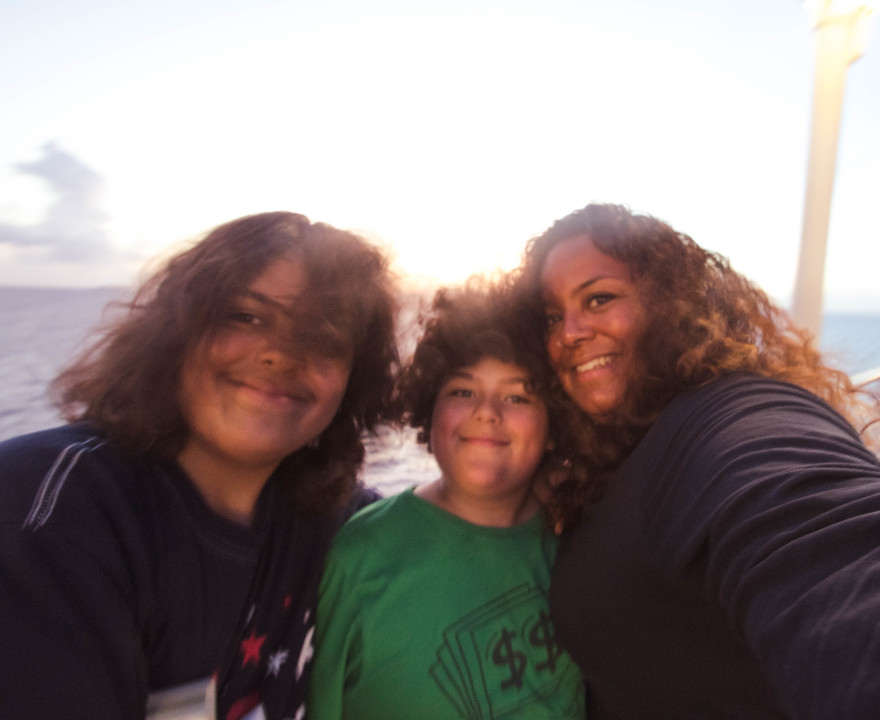
Our last night on the ship. Tired body, full heart.
I felt a bit protective of the Dominican experience. I was afraid that people would enter this with a sense of pity or voyeurism. I worried that it would be a fluff experience that did little of value to those whose space and time we were invading. But, I worried needlessly. The respect, humility, consideration, and friendship with which everyone I was with approached the activities – in great part to all the information and conversations had on the cruise beforehand, made this a wonderful experience for us and everyone I talked to.
I am hoping to see more destinations added to the Fathom Travel list that my family and I can take part in.
For a complete view of our adventure, check out my video! In it I share our Fathom Travel adventure, from start to finish, a view of the Adonia, as well the volunteer impact – in numbers – that the cruises to the island have made since its launch in April of 2016.
All photos are property of Girl Gone Travel® and may not be used without direct consent from the publisher.


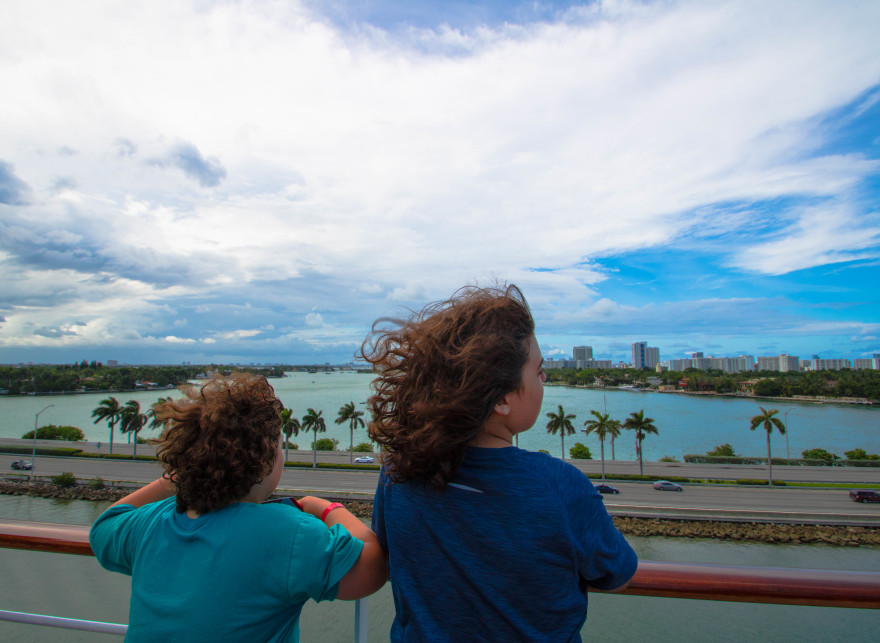

McCool Travel
Your feedback about the Fathom experience in Dominican Republic is more shall I say authentic than others. It was nice to see you and your children on the sailing. Travel Happy!
caincarol
McCool TravelHa! Thanks so much Charles! It was so great to see you too. I hope our paths cross again soon.